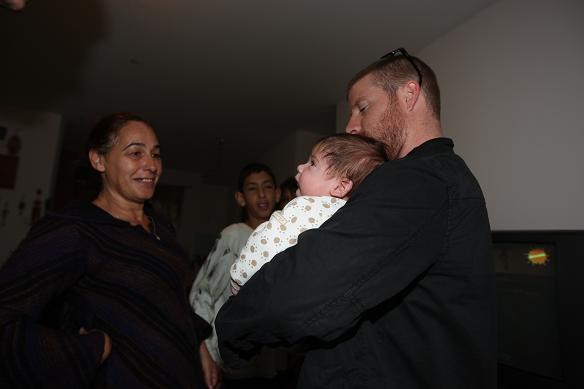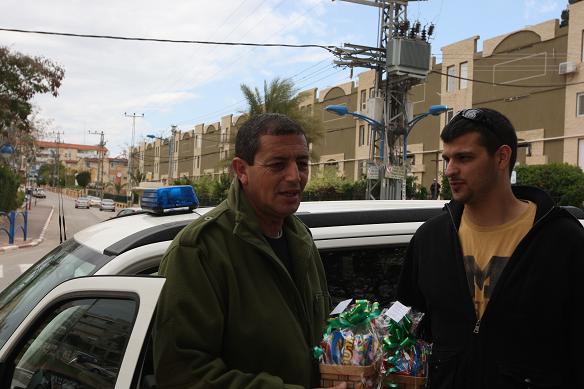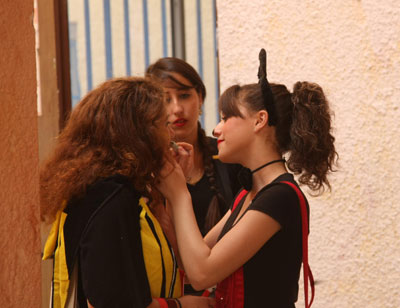“The next Megillah reading will be at 6:30 pm sharp,” said a voice on the intercom.
I was at the Jerusalem Central Bus Station. It was the eve of Purim and I had just arrived to the station from Ashkelon. The rain was pouring outside and I knew there was no way I would make it in time to the Megilah reading at the synagogue I usually attend near my home.
So I decided I would stay for the reading at the station, thinking to myself-not my ideal location but still–what other bus station in the world would offer unique opportunity on Purim?
I found the synagogue on the third floor which was quickly becoming full of people. Chabadniks, Breslavim, Haredim, Israeli soldiers, women in pants and men in payot. Religious, secular and traditional Jews were all gathering together to hear the story of our Jewish heroes from two thousand years ago.
Five minutes left before Megillah reading and not enough Megillahs to go around.
I looked around me. We were all strangers but there was that familiar feeling of family in the air. We were all here, all united in one purpose– to recall our story of national survival and strength over two thousand years ago.
It’s an ongoing story for our people and in Israel today the situation is no different.
I had come back to Jerusalem after spending the day in Sderot where I work for Sderot Media Center, a social media organization dedicated to bringing the voices of Sderot residents to the attention of the global community. As a media center, we have made many acquaintances and friends in the Sderot community, all of whom share survival stories from rocket attacks.
Consequently, every Purim we deliver mishloach manot, gifts of food and drink to families who have been victimized by Qassam fire.
The first family we visited that today was the Gad family, whose home was struck twice by Gaza rockets in the past, with the family inside the home both times. The mother, Chava has experienced severe symptoms of post trauma stress disorder and still has to take medication to help her relax.
Today, however Chava is happy in the way of new grandmothers. She proudly shows us her new grandson, the family’s first, and tells us how much she loves being a grandmother. It’s good to see Chava this way, happily playing with the baby with her three children standing next to her all wanting to take turns holding the newcomer.
*Chava Gad with new grandson, family and SMC director Noam Bedein, looking over.
Photo Credit: Thomas Rassloff
Next, we are off to the Chazans, Dahans, Sassons and Amar families, all of whom whose homes were hit by rockets within the last four years. In the festive spirit of the day, Mr. Chazan shows us an ancient scroll with the story of Purim inscribed by the hand of his grandfather over 100 years ago in Morocco. Mr. Chazan brought this scroll with him when he came to Israel and as he proudly tells us, he reads from it to his family every year on Purim.
Accompanying us during our visits, is a German photojournalist who has come to Sderot a few days after his visit to Gaza. He tells me that thus far, the most interesting photos he has shot since coming to this part of the Middle East were in Hebron last week.
At the Sasson family’s home, Shula the mother brings out a plate of home-baked sphinge, sweet Morrocan dough, which the German photographer gingerly tasted.
Shula is also in a happy mood today, as she recounts that this Purim has been one of the first holidays in a long time that her family has celebrated together without a siren or rocket explosion disrupting the day. Sasson, whose home was hit in a rocket attack that also heavily damaged her neighbors’ home in December 2007, however, is not completely calm. She tells us how a terrible clap of thunder in the early morning woke the entire family up, making them think that a rocket had exploded over a home.
*SMC delivers Purim gift to Sderot’s municipal security officer, Kobi Harush.
Photo Credit: Thomas Rassloff
For others still, the memories of rocket attacks linger even more sharply. When we visit the Yaakobov family, the two sons and their mother, Purim, greet us warmly. Missing is the father and husband, Yaakov. In the Yaakobov living room, there stands a modest memorial with a photo of the father Yaakov, who was killed in a rocket attack fired from northern Gaza three years ago.
Times are not easy for this family. The mother works full time trying to support her two sons alone. Fourteen-year-old Chanan, the youngest, is a good student and speaks to us animatedly with a ready smile. His older brother is more quiet and reserved. They talk about a party they want to attend later in the evening. Their small apartment has no bomb shelter.
I snap back to reality as the reading of the Megilla begins but not before I am thankful for the unique opportunity I had today in Sderot-to visit and be with families who have endured so much but continue onwards with the same determined spirit that has kept us going for centuries.
I recall the Jewish Queen of Persia, Esther and her uncle Mordechai around which the story of Purim centers. Back in their day, in a situation not so different from ours today, the kingdom of Persia aimed to carry out the mass destruction of the Jewish people in 127 countries. Granted it wasn’t through nuclear means. But Jewish heroes and strong leadership were vital to the survival of the Jewish people back then-and they still are today.
The Richard Goldstones and Naomi Chazans of today, Jewish leaders who have bitterly disappointed the people of Sderot and others with their detrimental actions and decisions, had the opportunity to be heroes but decided on what was popular and failed.
However, I only need to visit the people of Sderot to know that today our heroes come in the form of average everyday citizens who continue our tradition of faith and loyalty to who we are as a people in a time and place where the challenges to do so are constantly present.
*Celebrating Purim at a high school in Sderot.
Photo Credit: Thomas Rasloff












